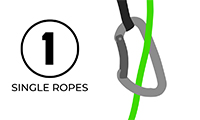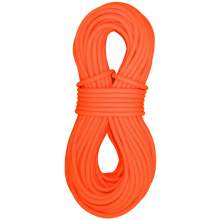9.0mm Fusion Nano IX 60m 2xDry
Description
Our original Nano was a perennial team favorite- the default sport climbing rope of choice for performance climbers. Now it gets reimagined as a triple threat: The Nano IX (Nine) arrives in a leaner (9mm), meaner, more versatile incarnation. Perfect for sport routes, ice, or mixed conditions, the Nano IX confidently surpasses expectations. Certified as a single, half, and twin rope, you get exceptional performance in a skinnier version of its very popular predecessor.
Retail price
This Product is Hard to Find.
We don’t know where you can buy this item online in the US. We’ll continue to check all the major retailers and will update this page as soon as we find one.
If you know where to find this online in the US, let us know, and we’ll add the link.

| Weight | 52.0 g/m 6.878 lbs / 3120 g |
| Diameter (millimeters) | 9.0 mm |
| Length (meters) | 60 m |
Rope Type  Type
There are 3 types of dynamic ropes that are used by climbers. They are known as Single, Half (Double), and Twin. The type of rope preferred varies by climbing style, location, and region. Single
By far, the most common type of rope. Great for indoors and out. In the US, it is the most common sport and big wall and are also used for trad cragging. The handling is simple and the diameter options are quite varied. Half (Double)
The best cure for a meandering route, only one of the ropes will clip into each piece of protection so a mindful climber can can reduce rope drag considerably. You can also rappel twice the distance, it’s easier to safely protect traverse pitches and there is a smaller chance that both ropes would become damaged (by rockfall, crampons, etc). Twin
Both ropes must be clipped through each piece of protection. This is the lightest style of (two) ropes. They excel for rappels, going twice the distance vs a single rope, but do not have the ability to mitigate rope drag even though there are two ropes. It is unlikely both ropes will be damaged at once, and is why many alpine, ice and mixed climbers choose twin and/or half ropes. Learn More
Every rope type and when to use them | Single/Half/Twin |
UIAA Falls (Single / Half / Twin)  UIAA FallsThis refers to the number of UIAA falls a rope has been tested to be able to withstand without breaking. The UIAA fall is a complicated test that is designed to create a uniform standard for strength in ropes, and is not generally reflective of real-world climbing situations. The test involves dropping a weight tied to the rope in such a way that it will see the highest amount of force a real-world situation could generate. The UIAA requires that Single and Half ropes must pass this test without breaking at least 5 times, while twin ropes must withstand 12 falls. In practice, it can likely be concluded that ropes that have higher than this standard number of falls will be stronger and put up with more abuse. It is important to note that any rope that is UIAA or EN certified is considered safe to climb on, regardless of the number of UIAA falls it is rated for. | 6 falls / 15 falls / 20 falls |
Dynamic Elongation (Single / Half / Twin)  Dynamic ElongationThis refers to the amount of stretch measured during the dynamic testing (or drop test) used when certifying ropes. Higher stretch will absorb more force and result in a softer catch but increases chances of groundfall at the beginning of a climb. The EN and UIAA require a stretch of at least 10% and no more than 40% for dynamic ropes. Single and Half ropes are tested individually and Twin ropes are tested as a pair. | 26.4 % / 27.6 % / 25.3 % |
Static Elongation (Single / Half / Twin)  Static ElongationThis refers to the amount of stretch measured during the static test used when certifying ropes. Most climbers will notice the difference in static elongation when climbing in a top rope situation, where higher stretch will make for a springier belay and could result in a ground fall when climbing closer to the ground. The EN and UIAA require a stretch of no more than 10% for Single and Twin ropes and no more than 12% for Half ropes. Single and Half ropes are tested individually and Twin ropes are tested as a pair. | 7.0 % / 7.0 % / 3.6 % |
Impact Force (Single / Half / Twin)  Impact ForceImpact force is the amount of force in kN that is measured at the testing mass during the UIAA dynamic drop rope test. When the weight is dropped, the force measured must be at or below 12kN for Single and Twin ropes and 8kN for Half ropes. The real world application of this test is determining that the rope can dissipate and absorb the appropriate amount of force from the fall as it would be felt by the climber. The variables used in the test set a situation that is well beyond anything climbers encounter, and shouldn't be considered realistic to actual climbing situations. In reality forces of this magnitude would result in severe injury as this test is designed to test the limits of the rope and not the comfort of the climber. | 8.50 kN / 6.60 kN / 10.40 kN |
Dry Treatment  Dry TreatmentWhen a rope is dry treated, it has had a coating applied to its core fibers, its sheath fibers, or both. The purpose of this coating is to reduce the amount of water the rope can absorb when in wet or icy conditions. Wet ropes are heavier, handle and belay differently, and have been tested to be weaker than dry ropes. Many climbers prefer dry treated ropes for very dusty or dirty environments, as they are more resistant to uptake of dirt and can stay cleaner longer. Learn More
Benefits of Dry vs Non-Dry ropes | Sheath & Core UIAA Certified Dry |
| Sheath Proportion (%) | 29.0 % |
| Sheath Slippage (mm) | |
| Type of Middle Mark | Marking |
| Rope End Marker | None |
| Certification | CE, EN, UIAA |
RFID / NFC Option  RFID and NCFThis technology can be helpful if you are a gym or professional business where you'd like to track the usage and age of your ropes. RFID is how items are uniquely identified using radio waves (Radio Frequency Identification). It's for 1-way communication from 10cm to 100m away depending on the frequency. Example: Airport Baggage. NFC is a subset of RFID that is restrained to close proximity communication typically less than 10cm (Near Field Communication). NFC chips can operate a 2-way signal to exchange information. Example: Apple Pay. | None |
No reviews yet.
We like a lot of things about the Sterling Fusion Nano IX. It's lightweight, handles well, and it fared pretty well during our tests. This is a great rope for certain situations, like a hard onsighting on a long route, but it's not the best everyday cragging rope. The new DryXP treatment also makes it suitable for Alpine and Ice climbs, though the rise of the Unicore lines has us preferring them in those situations due to the extra bit of safety that they provide. The Nano is still a great line though, and we'll be bringing this one out for those routes that go on forever.
The Sterling Fusion Nano IX was an excellent rope when it was first released two years ago, and it’s still near the top of the pack for skinny ropes. The new DryXP treatment in particular is excellent; I think when combined with the higher sheath-to-core proportion and inclusion of a middle mark, the new Nano IX is definitely an improvement over the previous version of the rope. That said, if you’re looking for a super durable rope, there are slightly burlier options out there, even at similar diameters. So, while I wouldn’t go out and replace a perfectly good rope based on these factors alone, if you’re in the market for a new skinny dry-treated rope, the Sterling Fusion Nano IX is an excellent choice.
The exceptional low weight and smooth handling are ultimately the reasons why the Nano IX took home our Top Pick award for the best alpine/sending rope. Shoppers should be aware that its small diameter did compromise its durability in our tests. But if you can stomach the fragility, this rope provides the weight savings to get you up your most ambitious goals.
Introducing Sterling new ropes for 2015.
You may not learn any technical specifications of the Sterling 9.2 Fusion Nano in this video, but it will show you how you can reduce rope drag so much that you can slay your next 5.16a project.
In this video Daila Ojeda talks about Sterling Rope and why she chooses 9.2mm Fusion Nano for climbing.
In this video Enzo Oddo explains why he chooses 9.2mm Fusion Nano of Sterling Rope.
In this video Whitney Boland talks about her life, her struggle against a chronic disease and climbing, she explains why she chooses Fusion Nano, Fusion Ion2 and Evolution Velocity ropes.
In this video Muriel talks about climbing, Sterling Rope and explains why she chooses Fusion Nano.
This video shows Chris Sharma talking about Sterling Ropes and explains why he use Fusion Nano.



























